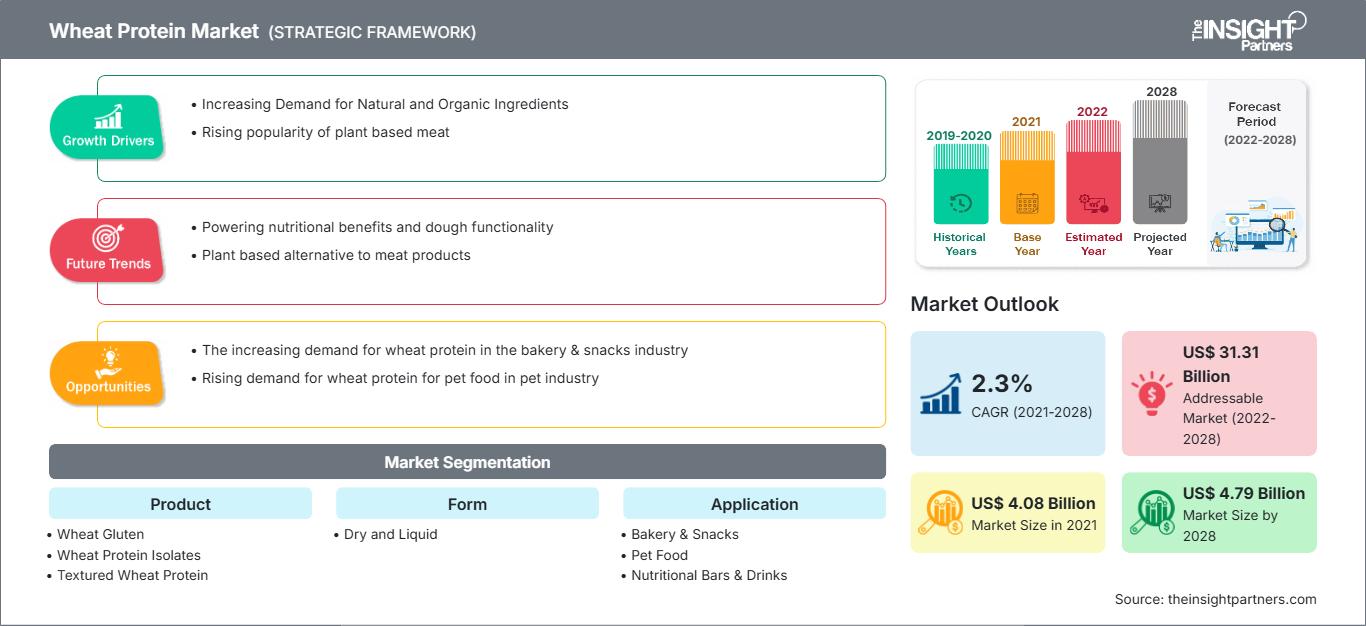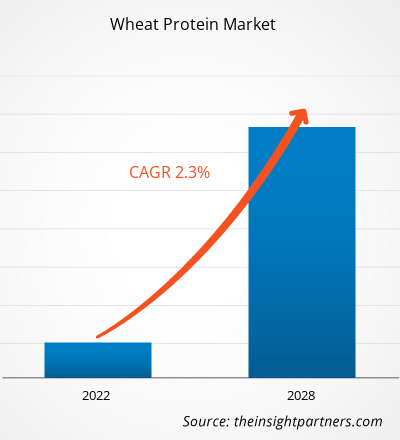[Rapport de recherche] Le marché des protéines de blé était évalué à 4 083,05 millions de dollars américains en 2021 et devrait atteindre 4 788,49 millions de dollars américains d'ici 2028 ; il devrait croître à un TCAC de 2,3 % de 2021 à 2028.
Les protéines de blé sont des protéines végétales principalement obtenues par la transformation du blé à l'aide de différentes enzymes. Ce sont des protéines fonctionnelles insolubles qui possèdent des caractéristiques viscoélastiques uniques et offrent élasticité et extensibilité au produit final. Ces protéines sont considérées comme une alternative viable aux protéines d'origine animale. Elles sont largement utilisées dans plusieurs industries d'utilisation finale, telles que la boulangerie et la confiserie, les cosmétiques et les soins personnels, l'alimentation animale et les compléments alimentaires.
En 2020, l'Europe détenait la plus grande part des revenus du marché mondial des protéines de blé. Le marché européen est segmenté entre l'Allemagne, la France, l'Italie, le Royaume-Uni, la Russie et le reste de l'Europe. La sensibilisation croissante des consommateurs aux questions de santé stimule la demande pour de nombreux produits à base de protéines végétales, comme le soja, le blé et l'avoine. La popularité des protéines de blé a augmenté dans toute la région, notamment en Allemagne, en France et au Royaume-Uni. Les Européens adoptent de plus en plus le régime flexitarien, c'est-à-dire qu'ils remplacent une partie ou la majeure partie de leur consommation de viande par des aliments protéinés alternatifs. Ces facteurs stimulent la demande de produits à base de protéines de blé en Europe.
Vous bénéficierez d’une personnalisation sur n’importe quel rapport - gratuitement - y compris des parties de ce rapport, ou une analyse au niveau du pays, un pack de données Excel, ainsi que de profiter d’offres exceptionnelles et de réductions pour les start-ups et les universités
Marché des protéines de blé: Perspectives stratégiques

-
Obtenez les principales tendances clés du marché de ce rapport.Cet échantillon GRATUIT comprendra une analyse de données, allant des tendances du marché aux estimations et prévisions.
De nombreux secteurs, comme celui de l'alimentation et des boissons, ont été confrontés à des défis sans précédent en raison de la pandémie de COVID-19. En raison de la pénurie d'approvisionnement en matières premières, de la fermeture des usines, du manque de main-d'œuvre et d'autres difficultés opérationnelles liées aux protocoles de sécurité liés à la COVID-19, les entreprises impliquées dans la fabrication de protéines de blé ont rencontré des difficultés au cours des premiers mois de la pandémie. Le secteur de l'alimentation et des boissons est le principal consommateur de protéines de blé et la pandémie de COVID-19 en cours a eu un impact négatif sur la demande de protéines de blé. Les produits alimentaires et les boissons, tels que les produits de boulangerie, les confiseries et les produits laitiers, sont repoussés, les supermarchés ayant réaffecté leurs stocks aux produits de base et aux fournitures essentielles en raison de l'épidémie. Cependant, alors que les économies reprennent leurs activités, la demande de protéines de blé devrait augmenter fortement dans le monde entier au cours des prochains mois. La pandémie de COVID-19 a entraîné une demande accrue de produits de boulangerie sains et fonctionnels, ce qui devrait alimenter la croissance du marché des protéines de blé dans les années à venir.
Aperçu du marché
Demande croissante d'ingrédients naturels et biologiques
L'importance des aliments biologiques a été reconnue suite à des problèmes de santé alarmants, à une sensibilisation croissante aux certifications biologiques et à une préférence croissante pour les aliments de haute qualité. Aujourd'hui, les consommateurs recherchent des ingrédients naturels, propres et simples, avec des étiquettes appropriées, qui peuvent efficacement communiquer leur composition, leur qualité et l'usage prévu du produit. De plus, ils dépendent largement des produits alimentaires biologiques et naturels. Par exemple, la consommation de protéines de blé biologiques a considérablement augmenté dans divers secteurs d'application, tels que l'alimentation et les boissons, ainsi que l'alimentation animale et aquatique. Ainsi, les fabricants de protéines de blé se concentrent sur le développement et la commercialisation de protéines de blé biologiques.
Informations sur les produits
Le marché mondial des protéines de blé est segmenté en fonction des produits : gluten de blé, isolats de protéines de blé, protéines de blé texturées et protéines de blé hydrolysées. En 2020, le segment du gluten de blé représentait la plus grande part de chiffre d'affaires. Le gluten de blé vital est utilisé comme additif en boulangerie. Il ajoute de l'élasticité aux farines, qui seraient autrement pauvres en gluten, comme la farine de blé complet ou le seigle. Le gluten de blé améliore également la levée de la pâte crue et améliore la texture et la consistance du produit final.
Informations sur la forme
Le marché des protéines de blé, par forme, est divisé en deux catégories : sèche et liquide. En 2020, le segment sec représentait une part de chiffre d'affaires plus importante. Français Parmi les propriétés des protéines de blé sèches, on peut citer leur grande solubilité dans l'eau quel que soit le pH, leur capacité à lier l'eau et à émulsifier, leur faible viscosité et leur stabilité acide et thermique. Les protéines de blé sèches sont de plus en plus utilisées dans les produits de boulangerie, les aliments pour animaux, les barres nutritionnelles, la viande transformée et les substituts de viande. Ainsi, les nombreuses applications dans l'industrie alimentaire soutiennent la croissance du marché des protéines sèches.
Aperçu des applications
Le marché des protéines de blé, par application, est segmenté en produits de boulangerie et snacks, aliments pour animaux, barres et boissons nutritionnelles, viande transformée, substituts de viande, et autres. En 2020, le segment des produits de boulangerie et snacks représentait la plus grande part de chiffre d'affaires. De nombreux produits de boulangerie, tels que les petits pains, le pain, les biscuits, les viennoiseries, les tartes et les muffins, sont populaires auprès des consommateurs. Les protéines de blé font partie des ingrédients courants qui optimisent le comportement de la pâte et améliorent les propriétés nutritionnelles des produits finis. La demande croissante de protéines de blé dans les produits de boulangerie et snacks L'industrie des snacks et la tendance du clean label créent de nombreuses opportunités pour les acteurs du marché mondial des protéines de blé.
Archer Daniels Midland Company ; Roquette Frères ; Glico Nutrition Co., Ltd ; Kröner-Stärke GmbH ; Cargill, Incorporated ; Crespel & Deiters GmbH & Co. KG ; CropEnergies AG ; Manildra Group ; MGP Ingredients Inc. ; et Tereos Group comptent parmi les acteurs bien établis du marché mondial des protéines de blé. Les entreprises du marché adoptent diverses stratégies, telles que le développement de produits, l'agrandissement d'usines et les fusions et acquisitions, pour étendre leur présence à l'échelle mondiale et répondre à la demande croissante des utilisateurs finaux. Par exemple, en 2020, Archer Daniels Midland Company a développé de nouveaux produits. Les produits contiennent des protéines de pois texturées Arcon T, des protéines de blé texturées Prolite MeatTEX et des protéines de blé non texturées Prolite MeatXT.
Points forts du rapport
- Tendances progressives de l'industrie sur le marché mondial des protéines de blé pour aider les acteurs à développer des stratégies efficaces à long terme
- Stratégies de croissance commerciale adoptées par les marchés développés et en développement
- Analyse quantitative du marché mondial des protéines de blé de 2019 à 2028
- Estimation de la demande de protéines de blé dans divers secteurs
- Évolutions récentes pour comprendre le scénario de marché concurrentiel et la demande de protéines de blé
- Tendances et perspectives du marché associées aux facteurs qui stimulent et freinent la croissance du marché des protéines de blé
- Processus décisionnel en comprenant les stratégies qui sous-tendent l'intérêt commercial concernant la croissance du marché mondial des protéines de blé
- Taille du marché des protéines de blé à différents nœuds du marché
- Aperçu détaillé et segmentation du marché mondial des protéines de blé ainsi que sa dynamique dans l'industrie
- Taille du marché des protéines de blé dans diverses régions avec des opportunités de croissance prometteuses
Aperçu régional du marché des protéines de blé
Les tendances régionales et les facteurs influençant le marché des protéines de blé tout au long de la période de prévision ont été analysés en détail par les analystes de The Insight Partners. Cette section aborde également les segments et la géographie du marché des protéines de blé en Amérique du Nord, en Europe, en Asie-Pacifique, au Moyen-Orient et en Afrique, ainsi qu'en Amérique du Sud et en Amérique centrale.
Portée du rapport sur le marché des protéines de blé
| Attribut de rapport | Détails |
|---|---|
| Taille du marché en 2021 | US$ 4.08 Billion |
| Taille du marché par 2028 | US$ 4.79 Billion |
| TCAC mondial (2021 - 2028) | 2.3% |
| Données historiques | 2019-2020 |
| Période de prévision | 2022-2028 |
| Segments couverts |
By Produit
|
| Régions et pays couverts |
Amérique du Nord
|
| Leaders du marché et profils d'entreprises clés |
|
Densité des acteurs du marché des protéines de blé : comprendre son impact sur la dynamique des entreprises
Le marché des protéines de blé connaît une croissance rapide, porté par une demande croissante des utilisateurs finaux, due à des facteurs tels que l'évolution des préférences des consommateurs, les avancées technologiques et une meilleure connaissance des avantages du produit. Face à cette demande croissante, les entreprises élargissent leur offre, innovent pour répondre aux besoins des consommateurs et capitalisent sur les nouvelles tendances, ce qui alimente la croissance du marché.

- Obtenez le Marché des protéines de blé Aperçu des principaux acteurs clés
- Analyse historique (2 ans), année de base, prévision (7 ans) avec TCAC
- Analyse PEST et SWOT
- Taille du marché Valeur / Volume - Mondial, Régional, Pays
- Industrie et paysage concurrentiel
- Ensemble de données Excel
Rapports récents
Témoignages
Raison d'acheter
- Prise de décision éclairée
- Compréhension de la dynamique du marché
- Analyse concurrentielle
- Connaissances clients
- Prévisions de marché
- Atténuation des risques
- Planification stratégique
- Justification des investissements
- Identification des marchés émergents
- Amélioration des stratégies marketing
- Amélioration de l'efficacité opérationnelle
- Alignement sur les tendances réglementaires






















 Obtenez un échantillon gratuit pour - Marché des protéines de blé
Obtenez un échantillon gratuit pour - Marché des protéines de blé